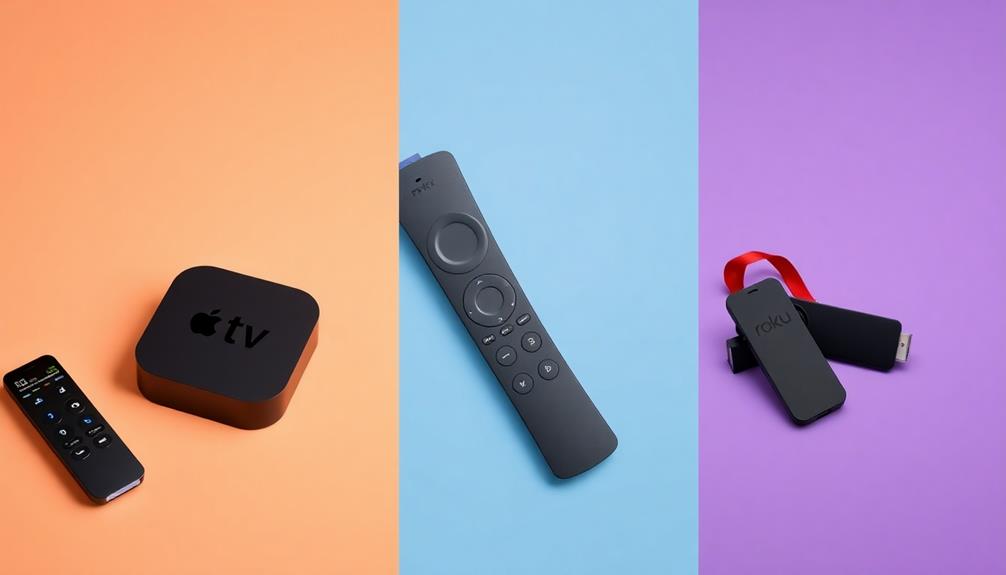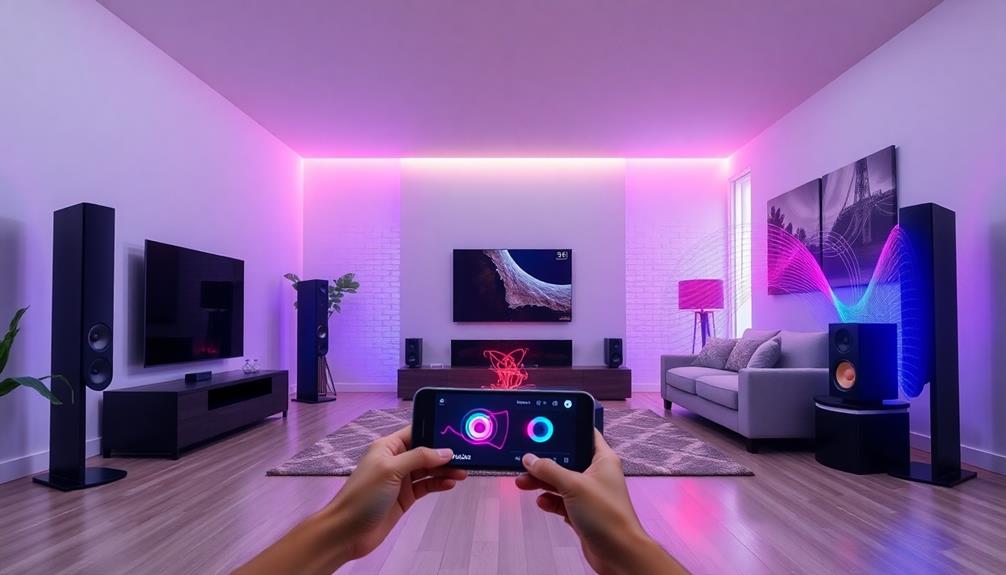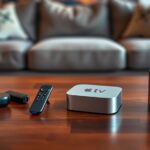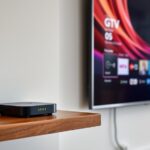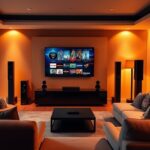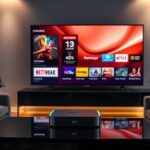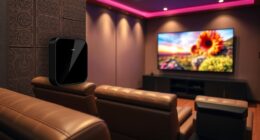When comparing streaming devices like Apple TV, Roku, and Fire TV Stick, you'll notice key differences in features and pricing. Apple TV 4K offers seamless integration with Apple products, while Roku boasts a vast selection of over 25,000 apps and a user-friendly interface. The Fire TV Stick is budget-friendly and includes Alexa for voice control. Each option supports major streaming services, but your choice depends on your ecosystem, budget, and desired features. Whether you're looking for premium quality or value, there's a perfect fit waiting for you, and more insights are just ahead!
Key Takeaways
- Price Point: Apple TV 4K is the most expensive option, while Roku and Fire TV Stick offer affordable alternatives for budget-conscious consumers.
- User Interface: Roku provides a simple navigation experience, while Apple TV features a clean design and Fire TV has a more complex, ad-laden interface.
- Streaming Quality: Apple TV 4K supports superior HDR10+ and Dolby Vision, with Roku and Fire TV Stick also offering robust streaming capabilities.
- Ecosystem Compatibility: Apple TV is best for Apple users, Roku excels in versatility, and Fire TV is ideal for Amazon Prime subscribers.
- Unique Features: Apple TV integrates with Apple services, Roku boasts a vast channel library, and Fire TV includes Alexa for voice control.
Overview of Streaming Devices
When it comes to streaming devices, your options can feel overwhelming, but each offers unique features tailored to different needs. Roku stands out for its user-friendly interface and extensive channel library, making it incredibly accessible for all users.
If you value premium features and seamless integration with other Apple products, the Apple TV 4K could be your best bet. Its high-speed performance with A12 and A15 Bionic processors guarantees smooth streaming, catering to those who want the best experience.
On the other hand, if you're looking for budget-friendly options, the Amazon Fire TV Stick fits the bill. It offers Alexa integration, letting you control your entertainment hands-free. However, be prepared for an interface that might feel a bit cluttered with ads compared to Roku and Apple TV 4K.
All three devices support major streaming services like Netflix, Hulu, and Disney+, giving you access to a wide range of content.
Ultimately, whether you choose Roku, Apple TV 4K, or Amazon Fire TV Stick depends on your preferences and budget, assuring there's something for everyone in the streaming landscape.
Key Features Comparison
Streaming devices frequently come with a variety of key features that can greatly impact your viewing experience. The Apple TV 4K stands out with its powerful A15 Bionic chip, supporting HDR10+ and Dolby Vision, which is perfect if you're already invested in the Apple ecosystem.
You'll enjoy seamless integration with Apple services, enhancing your overall experience.
On the other hand, the Roku Streaming Stick 4K offers a user-friendly interface and access to over 25,000 apps, making it a versatile choice for exploring diverse content.
It also supports Dolby Vision, ensuring high-quality streaming.
If you're leaning towards Amazon, the Amazon Fire TV Stick 4K Max is a solid option. It supports Dolby Vision and Dolby Atmos, while the addition of Wi-Fi 6E enhances connectivity.
Plus, with Alexa voice control, you can easily navigate through your favorite shows and movies.
Ultimately, whether you choose the Apple TV 4K, Roku Streaming Stick, or Amazon Fire TV Stick, each device has unique features that cater to different user preferences, ensuring you find the perfect fit for your streaming needs.
Pricing and Value
When it comes to pricing, you'll find a wide range of options that cater to different budgets.
The value for money varies considerably, with affordable choices like the Roku Streaming Stick 4K and Onn. Google TV 4K offering solid features for less.
Keep an eye out for special offers, as they can make a great device even more appealing.
Price Comparison Overview
Steering through the world of streaming devices can be overwhelming, especially when considering price and value.
When you conduct a price comparison, you'll find that the Apple TV 4K (3rd Generation) is the most expensive option, priced around $149-$150.
If you're looking for something more budget-friendly, the Roku Streaming Stick 4K stands out at a competitive price range of $34-$50, making it a great choice for users who want 4K streaming without breaking the bank.
The Amazon Fire TV Stick 4K Max also offers a solid performance at a similar price point, typically retailing for $35-$60. This makes it another excellent budget-friendly alternative.
For those who want a mid-range option, the Roku Ultra (2024) is available between $79-$100, boasting advanced capabilities compared to basic Roku models.
Value for Money
Finding the best value for your money in streaming devices can make all the difference in your viewing experience. When considering options like the Apple TV 4K and the Fire TV Stick, it's crucial to weigh features against price.
Here's a quick comparison to help you decide:
- Roku Streaming Stick 4K: Priced between $34-$50, it offers a user-friendly interface and extensive app library, making it a top choice for budget-conscious consumers.
- Apple TV 4K (3rd Generation): At around $149-$150, it's great for those in the Apple ecosystem but may not offer the best value for money compared to competitors.
- Fire TV Stick 4K Max: Typically priced around $35-$60, it delivers solid performance with Alexa integration, making it a fantastic option for Amazon Prime users.
- Roku Ultra: Ranges from $79-$100, featuring high-end specs like Dolby Vision, which justifies the higher price for serious streamers.
- Onn. Google TV 4K Streaming Box: The most economical choice at around $20, perfect for 4K streaming without a big commitment.
In short, each device has its strengths, so choose based on your needs and budget!
Special Offers Available
Many consumers are on the lookout for special offers that can enhance the value of their streaming device purchase. Each option brings unique pricing strategies to the table, catering to diverse budgets and preferences.
Here's a quick comparison of the current prices and offers available:
| Streaming Device | Price Range |
|---|---|
| Apple TV 4K | $149 – $150 |
| Roku Ultra | $79 – $100 |
| Fire TV Stick 4K Max | $35 – $60 |
The Apple TV 4K appeals to those invested in the Apple ecosystem, but it comes with a higher price tag. If you're seeking a mid-range option, the Roku Ultra offers advanced features without breaking the bank. On the budget-friendly end, the Fire TV Stick 4K Max is an excellent choice, especially for Amazon Prime users looking for Alexa integration.
Additionally, keep an eye out for seasonal promotions or bundle deals, as these can greatly improve the overall value of your purchase. Whether you opt for the premium Apple TV 4K, the versatile Roku Ultra, or the economical Fire TV Stick 4K Max, there's an option for everyone.
User Interface and Experience
When choosing a streaming device, the user interface and experience can make or break your viewing habits.
You'll want to evaluate how easily you can navigate through apps, the level of customization available, and the overall accessibility of content.
Each device offers a unique approach, so let's explore how they stack up in these key areas.
Navigation Simplicity
Simplicity is key when it comes to managing streaming devices, as a user-friendly interface can greatly enhance your viewing experience. Roku, Apple TV, and Fire TV Stick each have their own approach to navigation simplicity, impacting how easily you can find and enjoy content.
- Roku offers a straightforward home screen with access to over 25,000 apps, making it ideal for all users, even those less tech-savvy.
- Apple TV features a clean interface that integrates with other Apple devices, allowing you to navigate with familiar gestures and Siri voice commands.
- Fire TV Stick has a more complex interface filled with ads and promotional content, which can clutter your experience and complicate navigation.
- Roku's universal search function simplifies finding content across multiple services, so you won't have to jump between apps.
- Apple TV enhances efficiency by enabling seamless multitasking, allowing you to quickly switch between apps and access a unified library.
Customization Options
Maneuvering between streaming devices isn't just about ease; it's also about how much you can tailor your experience. When you consider customization options, you'll notice distinct differences among Apple TV, Roku, Fire TV Stick, and Google TV.
Roku offers a simple, app-based menu that prioritizes straightforward navigation over extensive personalization, making it perfect if you value simplicity. On the other hand, Apple TV provides a clean and intuitive interface that works seamlessly with other Apple devices, but it limits customization compared to its competitors.
If you want a more personalized experience, Google TV stands out, allowing you to receive customized recommendations based on your viewing habits. However, its setup might take a bit longer and feel more complex initially.
Meanwhile, the Fire TV Stick integrates Alexa for voice control, but its interface can feel cluttered with ads, which restricts your customization options.
App Accessibility
App accessibility plays an essential role in enhancing your streaming experience, and each device offers unique strengths in this area.
- Roku: Known for its user-friendly interface, it boasts over 25,000 apps, making navigation simple and straightforward.
- Apple TV: With a clean design, it integrates seamlessly with the Apple ecosystem, allowing easy access to services like Apple Music and Apple Arcade.
- Amazon Fire TV Stick: Its voice control feature via Alexa simplifies app accessibility, but the ad-heavy layout might detract from your user experience.
- Google TV: This option focuses on personalized content recommendations based on your viewing habits, making it easier to discover new apps and services.
- Overall: Roku excels in straightforward navigation, Apple TV shines in design and integration, and Fire TV stands out for voice command capabilities, despite potential clutter.
Streaming Quality and Performance
When it comes to streaming quality and performance, choosing the right device can make all the difference in your viewing experience. Each device offers unique strengths that impact how you enjoy your favorite streaming apps.
| Device | Streaming Quality | Performance |
|---|---|---|
| Apple TV 4K | 4K resolution, HDR10+ | Fast app loading, seamless multitasking |
| Roku Streaming Stick 4K | Dolby Vision, HDR10+ | User-friendly interface, reliable streaming |
| Amazon Fire TV Stick 4K Max | Dolby Vision, Dolby Atmos | Wi-Fi 6E support, reduced buffering |
The Apple TV 4K stands out with its A15 Bionic chip, delivering superior visual clarity. Roku's compact design enhances portability while ensuring vibrant colors and detailed images. Meanwhile, the Fire TV Stick 4K Max excels with immersive audio-visual experiences and improved streaming performance thanks to its Wi-Fi 6E support.
Compatibility With Ecosystems
Choosing the right streaming device often comes down to how well it fits into your existing ecosystem. If you're all-in on Apple products, the Apple TV is your best bet. It integrates seamlessly with Apple services like Apple Music and Apple Arcade, and offers features like AirPlay and HomeKit for smart home control.
On the other hand, if you prefer a more open system, Roku stands out. It supports a wide range of streaming services without being tied to any specific ecosystem, making it versatile for various user preferences.
For those who are deeply invested in Amazon, the Fire TV provides a robust experience. It features Alexa voice control, easy access to Prime Video, and compatibility with other Amazon devices, making it appealing for Amazon users.
Here's a quick comparison:
- Apple TV: Best for Apple device owners
- Roku: Great for users wanting flexibility
- Fire TV: Ideal for Amazon Prime subscribers
- Roku & Fire TV: Better third-party app compatibility
- Apple TV: Prioritizes Apple-centric services
Ultimately, your choice will hinge on your current tech investments.
Unique Selling Points
Distinctive features set each streaming device apart, catering to various user needs and preferences.
The Apple TV 4K stands out with its seamless integration into the Apple ecosystem. If you already own Apple products, you'll love the ease of using AirPlay and Siri voice control. Plus, the A15 Bionic chip guarantees exceptional performance, while HDR10+ and Dolby Vision provide stunning video quality.
On the other hand, the Roku Streaming Stick 4K is your go-to for a user-friendly experience. With over 25,000 channels available, it offers an impressive variety of content that's perfect for anyone who values choice and simplicity. Its intuitive interface makes navigation a breeze, so you can find your favorite shows without hassle.
Lastly, the Amazon Fire TV Stick 4K Max appeals to smart home enthusiasts. With Alexa voice control and the unique Ambient Experience mode, you can transform your TV into a dynamic art display when you're not streaming.
This device strikes a balance between functionality and aesthetics, making it a great addition to any home. Each device has something unique to offer, so you can choose based on your specific needs.
Best Use Cases
Considering your unique preferences and needs, selecting the right streaming device can greatly enhance your viewing experience. Each option caters to different user scenarios, so let's break down the best use cases for Apple TV, Roku devices, and Fire TV Stick.
- Apple TV: Perfect if you're already in the Apple ecosystem, as it seamlessly integrates with your iPhone and iPad.
- Roku devices: Ideal for those who crave variety, boasting over 25,000 channels and an easy-to-navigate interface.
- Fire TV Stick: Tailored for Amazon Prime members, it provides quick access to Prime Video and Alexa voice control for convenience.
- Roku: Recommended for families, its user-friendly design and robust parental controls guarantee a safe viewing environment for kids.
- Apple TV: A great choice for gamers with its powerful A15 Bionic chip, allowing for high-performance gaming alongside streaming.
Final Recommendations
When it comes to selecting the right streaming device, your specific needs and preferences play a crucial role in making the best choice. If you're deeply invested in the Apple ecosystem and want high-quality video, the Apple TV 4K is your go-to option. Its seamless integration and premium features justify the higher price tag of around $149-$150.
For those looking for a versatile and budget-friendly choice, the Roku Streaming Stick 4K stands out with its user-friendly interface and extensive app library, priced between $34-$50. It's perfect if you want a no-fuss experience without being tied to any specific ecosystem.
If you're on a tighter budget, consider the Roku Express for a solid 1080p streaming experience at about $29.
On the other hand, if voice control is a priority, the Amazon Fire TV Stick 4K Max, priced around $35-$60, offers Alexa integration, although you might find its ad-heavy interface less appealing.
Ultimately, weigh your budget, desired features, and ecosystem compatibility to find the streaming device that fits you best.
Frequently Asked Questions
Which Is Better, Apple TV or Amazon Fire Stick?
When comparing Apple TV and Amazon Fire Stick, consider your budget and ecosystem preferences. If you value seamless integration and performance, Apple TV's the way to go. For affordability and Amazon services, choose the Fire Stick.
Which Is Better, Apple TV or Roku?
When deciding between Apple TV and Roku, consider your budget and ecosystem. If you value a sleek interface and premium features, Apple TV's for you. Otherwise, Roku's affordability and content variety might better suit your needs.
What Is the #1 Streaming Device?
Wondering what the best streaming device is? You'll find the Roku Streaming Stick 4K often claims that title due to its affordability, user-friendly interface, and vast selection of channels. It's hard to beat!
Which Streaming Device Has the Most Free Channels?
If you're looking for the streaming device with the most free channels, Roku's your best bet. It offers over 5,000 channels, including a wide range of free options that surpass other platforms considerably.
Conclusion
In the ever-evolving world of streaming, choosing between Apple TV, Roku, and Fire TV Stick can feel like traversing the labyrinth of Greek mythology. Each device offers unique advantages tailored to different needs. Whether you're a die-hard Apple fan or someone who loves the versatility of Roku, there's a perfect fit out there for you. So, embrace the quest, weigh your options wisely, and plunge into the streaming adventure that awaits!
Hello, I’m Art, and I’m excited to be a part of the 1Home Theatre Projector team. As a writer, I’m here to contribute my knowledge and insights to help you achieve the ultimate home cinema experience. I understand that making decisions in the world of home entertainment can be complex, and I’m here to simplify the process for you.
